Evaluation of Photoelectrocatalysis with Electrode Based on Ti/RuO2-TiO2 Modified with Tin and Tantalum Oxides for the Degradation of Indigo Blue Dye
Abstract
1. Introduction
2. Experimental
2.1. Preparation of Electrodes
2.2. Characterization of Electrodes
2.2.1. Physicochemical Characterization
2.2.2. Electrochemical Characterization
2.3. IB Dye Degradation Assays
2.3.1. Electrocatalysis
2.3.2. Photocatalysis
2.3.3. Photoelectrocatalysis
3. Results and Discussion
3.1. Physicochemical Characterization
3.1.1. X-ray Diffraction
3.1.2. Scanning Electron Microscopy
3.2. Electrochemical Characterization
3.2.1. Cyclic Voltammetry
3.2.2. Stability Test
3.3. Indigo Blue Dye Degradation Assays
3.3.1. Electrocatalysis
3.3.2. Photocatalysis
3.3.3. Photoelectrocatalysis
4. Conclusions
Author Contributions
Funding
Data Availability Statement
Acknowledgments
Conflicts of Interest
References
- Moraes, L.A.R. Aplicação da Fotocatálise Heterogênea Para a Degradação de Corantes de Uma Indústria de Cosméticos. Master’s Thesis, Universidade de São Paulo, São Carlos, Brazil, 2010. [Google Scholar]
- Batista, R.M.F. Corantes azo Para Impressão a Jacto de Tinta com boa Solidez à Água. Master’s Thesis, Universidade do Minho, Braga, Portugal, 2005. [Google Scholar]
- Melo, K.S.G. Extração e Uso de Corantes Vegetais da Amazônia no Tingimento do Couro de Matrinxã (Brycon Amazonicu Spix & Agassiz, 1819). Master’s Thesis, Instituto Nacional de Pesquisas da Amazônia, Amazônia, Brazil, 2007. [Google Scholar]
- Peixoto, F.P.; Marinho, G.; Rodrigues, K. Corantes Têxteis: Uma revisão. Holos 2013, 5, 98–106. [Google Scholar] [CrossRef]
- Azanaw, A.; Birlie, B.; Teshome, B.; Jemberie, M. Textile effluent treatment methods and eco-friendly resolution of textile wastewater. Case Stud. Chem. Environ. Eng. 2022, 6, 100230. [Google Scholar] [CrossRef]
- Tagarro Tomaz, A.; Cristina Barthus, R.; Regina Costa, C.; Ribeiro, J. Descontaminação de Águas Residuais Contendo Poluentes Orgânicos: Uma Revisão. Rev. Virtual Quím. 2022. [Google Scholar] [CrossRef]
- Ramos, M.; Lima, J.; Aquino, S.; Aguiar, A. A critical analysis of the alternative treatments applied to effluents from Brazilian textile industries. J. Water Process Eng. 2021, 43, 102273. [Google Scholar] [CrossRef]
- Mahmoudi, F.; Saravanakumar, K.; Maheskumar, V.; Njaramba, L.K.; Yoon, Y.; Park, C.M. Application of perovskite oxides and their composites for degrading organic pollutants from wastewater using advanced oxidation processes: Review of the recent progress. J. Hazard. Mater. 2022, 436, 129074. [Google Scholar] [CrossRef]
- Priyadarshini, M.; Das, I.; Ghangrekar, M.M.; Blaney, L.J. Advanced oxidation processes: Performance, advantages, and scale-up of emerging technologies. Environ. Manag. 2022, 316, 115295. [Google Scholar] [CrossRef]
- Kumar, V.; Shah, M.P. Advanced Oxidation Processes for Effluent Treatment Plants; Elsevier: Amsterdam, The Netherlands, 2021; pp. 1–31. [Google Scholar]
- Cao, D.; Wang, Y.; Zhao, X. Combination of photocatalytic and electrochemical degradation of organic pollutants from water. Curr. Opin. Green Sustain. Chem. 2017, 6, 78–84. [Google Scholar] [CrossRef]
- Nogueira, R.F.P.; Jardim, W.F. A fotocatálise heterogênea e sua aplicação ambiental. Quim. Nova 1998, 21, 69. [Google Scholar] [CrossRef]
- Meng, X.; Zhang, Z. Two dimensional graphitic materials for photoelectrocatalysis: A short review. Catal. Today 2018, 315, 2–8. [Google Scholar] [CrossRef]
- Ye, S.; Chen, Y.; Yao, X.; Zhang, J. Simultaneous removal of organic pollutants and heavy metals in wastewater by photoelectrocatalysis: A review. Chemosphere 2021, 273, 128503. [Google Scholar] [CrossRef]
- Ayoubi-Feiz, B.; Soleimani, D.; Sheydaei, M.J. Taguchi method for optimization of immobilized Dy2O3/graphite/TiO2/Ti nanocomposite preparation and application in visible light photoelectrocatalysis process. Electroanal. Chem. 2019, 849, 113377. [Google Scholar] [CrossRef]
- Coteiro, R.D.; Teruel, F.S.; Ribeiro, J.; de Andrade, A.R. Effect of solvent on the preparation and characterization of DSA®-type anodes containing RuO2-TiO2-SnO2. J. Braz. Chem. Soc. 2006, 17, 771–782. [Google Scholar] [CrossRef]
- Zhao, Y.; Fan, Q.; Wang, X.; Zhang, W.; Hu, X.; Liu, C.; Liang, W. Photoelectrocatalytic degradation of microcystin-LR using a dimensionally stable anode and the assessment of detoxification. J. Chem. Eng. 2019, 368, 968. [Google Scholar] [CrossRef]
- Vasconcellos, M.D.L.S.; Silva, L.R.G.; Lee, C.-S.; Fajardo, A.S.; Garcia-Segura, S.; Ribeiro, J. Dimensionally Stable Anode Based Sensor for Urea Determination via Linear Sweep Voltammetry. Sensors 2021, 21, 3450. [Google Scholar] [CrossRef] [PubMed]
- Ken, D.S.; Sinha, A. Dimensionally stable anode (Ti/RuO2) mediated electro-oxidation and multi-response optimization study for remediation of coke-oven wastewater. J. Environ. Chem. Eng. 2021, 9, 105025. [Google Scholar] [CrossRef]
- Chen, S.; Zhou, L.; Yang, T.; He, Q.; Zhou, P.; He, P.; Dong, F.; Zhang, H.; Jia, B. Thermal decomposition based fabrication of dimensionally stable Ti/SnO2–RuO2 anode for highly efficient electrocatalytic degradation of alizarin cyanin green. Chemosphere 2020, 261, 128201. [Google Scholar] [CrossRef]
- Yu, S.; Gao, Y.; Khan, R.; Liang, P.; Zhang, X.; Huag, X. Electrospun PAN-based graphene/SnO2 carbon nanofibers as anodic electrocatalysis microfiltration membrane for sulfamethoxazole degradation. J. Membr. Sci. 2020, 614, 118368. [Google Scholar] [CrossRef]
- Bravo-Yumi, N.; Espinoza-Montero, P.; Picos-Benítez, A.; Navarro-Mendoza, R.; Brillas, E.; Peralta-Hernández, J.M. Synthesis and characterization of Sb2O5-doped Ti/SnO2-IrO2 anodes toward efficient degradation tannery dyes by in situ generated oxidizing species. Electrochim. Acta 2020, 358, 136904. [Google Scholar] [CrossRef]
- Niu, B.; Chen, Z.; Xu, Z. Recycling waste tantalum capacitors to synthesize high value-added Ta2O5 and polyaniline-decorated Ta2O5 photocatalyst by an integrated chlorination-sintering-chemisorption process. J. Clean. Prod. 2020, 252, 117206. [Google Scholar] [CrossRef]
- Vercesi, G.; Rolewicz, J.; Comninellis, C. Characterization of DSA-type oxygen evolving electrodes choice of base metal. Thermochim. Acta 1991, 21, 335–354. [Google Scholar] [CrossRef]
- Gonzalez, I.L.; Moreira, J.A.B.; de Andrade, A.R.; Ribeiro, J. Estudo da Reação de Desprendimento de Oxigênio em Eletrodos do Tipo Ta/RuO2-Ta2O5-TiO2. Rev. Virtual De Quím. 2016, 8, 8–16. [Google Scholar]
- Balan, D.S.L.; Monteiro, R.T.R. Decolorization of textile indigo dye by ligninolytic fungi. J. Biotechnol. 2001, 89, 141–145. [Google Scholar] [CrossRef] [PubMed]
- Albuquerque, M.V.; Ramos, R.; Brito, A.L.; Lopes, W.S. Aplicação de processos oxidativos na degradação dos corantes índigo blue e azul de metileno. In Proceedings of the Anais do Congresso Brasileiro de Gestão Ambiental e Sustentabilidade, Paraiba, Brasil, 6 December 2015. [Google Scholar]
- Sanromán, M.A.; Pazos, M.; Ricart, M.T.; Cameselle, C. Selection of an electrolyte to enhance the electrochemical decolourisation of indigo. Optimisation and scale-up. Chemosphere 2004, 60, 1080–1086. [Google Scholar]
- Scholz, F.; Bond, A.M.; Compton, R.G.; Fiedler, D.A.; Inzelt, G.; Kahlert, H.; Komorsky-Lovrić, Š.; Lohse, H.; Lovrić, M.; Marken, F.; et al. (Eds.) Electroanalytical Methods; Springer: Berlin/Heidelberg, Germany, 2010. [Google Scholar]
- Safra, L.C.P.G. Obtenção de Fios em Ligas de Cobre Para Utilização em Linhas de Transmissão e em Eletrodos Para Contatos Elétricos. Master’s Thesis, Universidade de São Paulo, São Paulo, Brazil, 2011. [Google Scholar]
- Lima, F.M.; Martins, F.M.; Maia Júnior, P.H.F.; Almeida, A.F.L.; Freire, F.N.A. Nanostructured titanium dioxide average size from alternative analysis of Scherrer’s Equation. Matéria 2018, 23. [Google Scholar] [CrossRef]
- Cheng, H.; Zhao, Z. Hydrothermal Preparation of Uniform Nanosize Rutile and Anatase Particles. Chem. Mater. 1995, 7, 663–671. [Google Scholar] [CrossRef]
- Cavasotto, T. Obtenção e Caracterização de Óxido de Cério, Obtido a Partir da Decomposição Térmica do TRIS (8-hidroxiquinolinato)cério (III). Master’s Thesis, Universidade Tecnológica Federal do Paraná, Paraná, Brazil, 2015. [Google Scholar]
- Pandolfo, F.G. Análise Modal de Materiais Compósitos. Master’s Thesis, Universidade de Caxias do Sul, Rio Grande do Sul, Brazil, 2006. [Google Scholar]
- Ribeiro, J.; De Andrade, A.R. Characterization of RuO2 —Ta2O5 Coated Titanium Electrode: Microstructure, Morphology, and Electrochemical Investigation. J. Electrochem. Soc. 2004, 151, D106–D112. [Google Scholar] [CrossRef]
- Costa, C.R.; Montilla, F.; Morallón, E.; Olivi, P. Electrochemical oxidation of acid black 210 dye on the boron-doped diamond electrode in the presence of phosphate ions: Effect of current density, pH, and chloride ions. Electrochim. Acta 2009, 54, 7048–7055. [Google Scholar] [CrossRef]
- Cerrón-Calle, G.A.; Aranda-Aguirre, A.J.; Luyo, C.; Garcia-Segura, S.; Alarcón, H. Photoelectrocatalytic decolorization of azo dyes with nano-composite oxide layers of ZnO nanorods decorated with Ag nanoparticles. Chemosphere 2019, 219, 296–304. [Google Scholar] [CrossRef]
- Trasatti, S. Physical electrochemistry of ceramic oxides. Electrochim. Acta 1991, 36, 2. [Google Scholar] [CrossRef]
- Cestarolli, D.T.; de Andrade, A.R. Electrochemical and morphological properties of Ti/Ru0.3Pb(0.7−x)TixO2-coated electrodes. Electrochim. Acta. 2003, 43, 4137. [Google Scholar] [CrossRef]
- Fathollahi, F.; Javanbakht, M.; Norouzi, P.; Ganjali, M.R. Comparison of morphology, stability and electrocatalytic properties of Ru0.3Ti0.7O2 and Ru0.3Ti0.4Ir0.3O2 coated titanium anodes. Russ. J. Electrochem. 2011, 47, 1281. [Google Scholar] [CrossRef]
- Soni, B.D.; Patel, U.D.; Agrawal, A.; Ruparelia, J.P. Electrochemical destruction of RB5 on Ti/PtOx–RuO2–SnO2–Sb2O5 electrodes: A comparison of two methods for electrode preparation. Int. J. Environ. Sci. Technol. 2020, 17, 903. [Google Scholar] [CrossRef]
- Huang, H.; Kim, H.; Lee, A.; Kim, S.; Won-Gwang, L.; Park, C.; Kim, S.; Kim, S.; Lee, J. Structure engineering defective and mass transfer-enhanced RuO2 nanosheets for proton exchange membrane water electrolyzer. Nano Energy 2021, 88, 106276. [Google Scholar] [CrossRef]
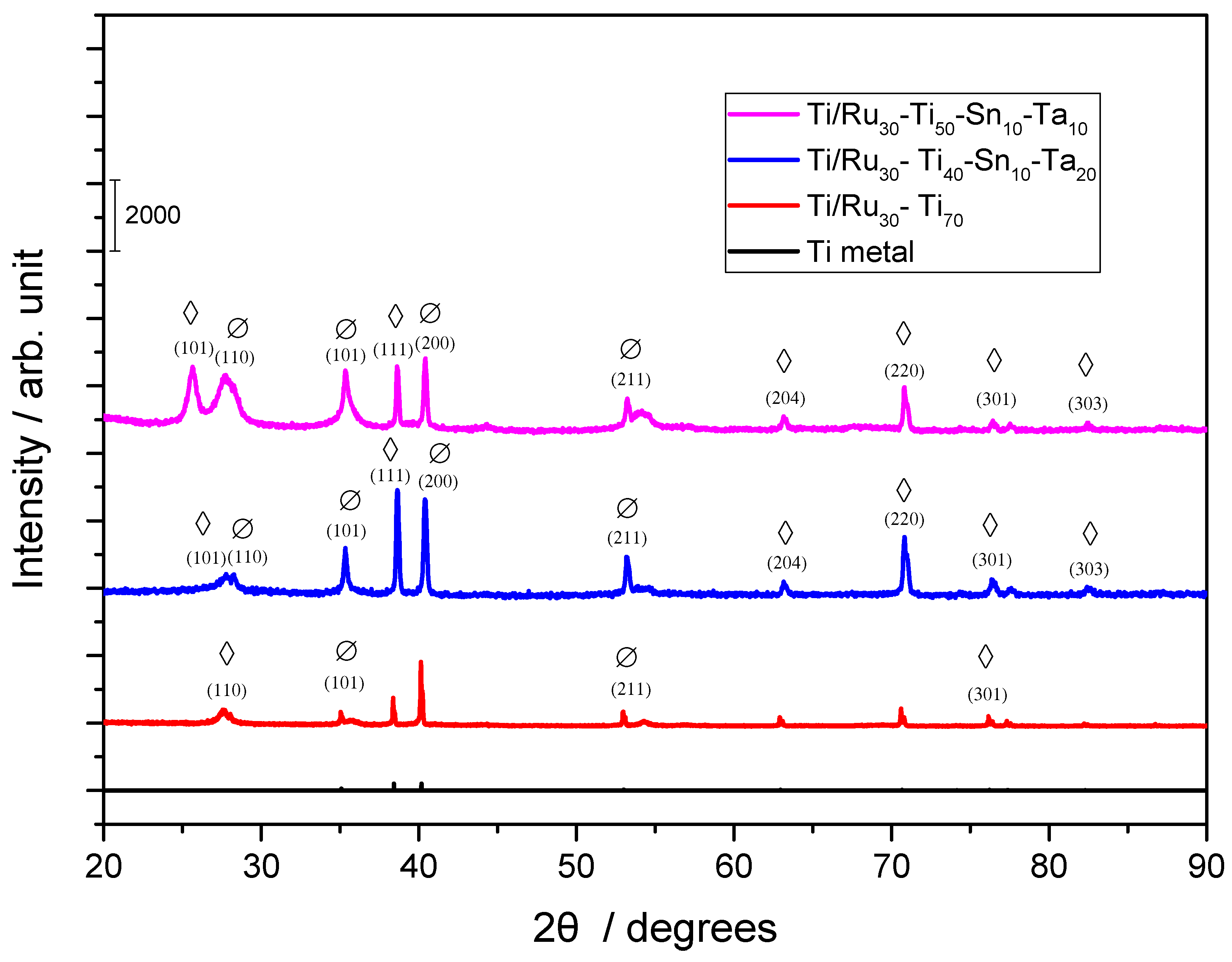

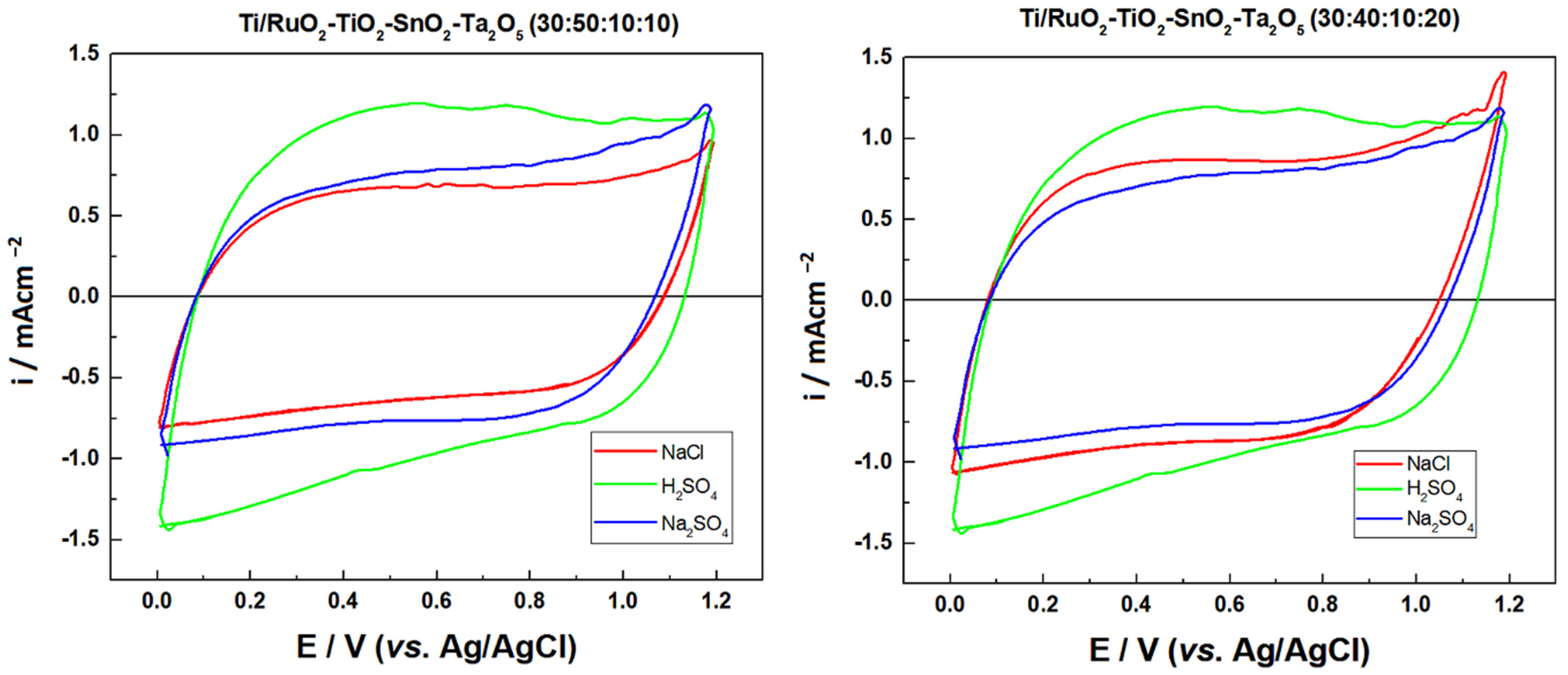
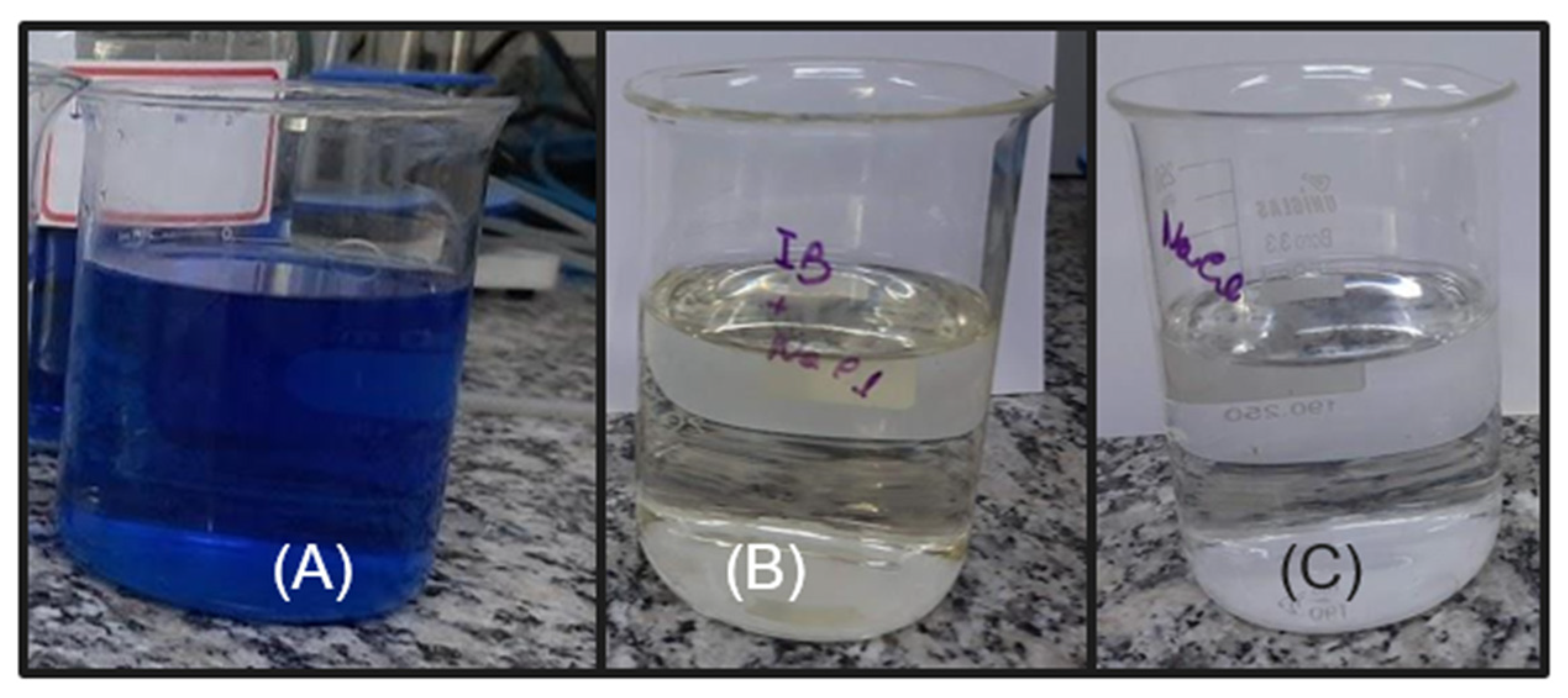
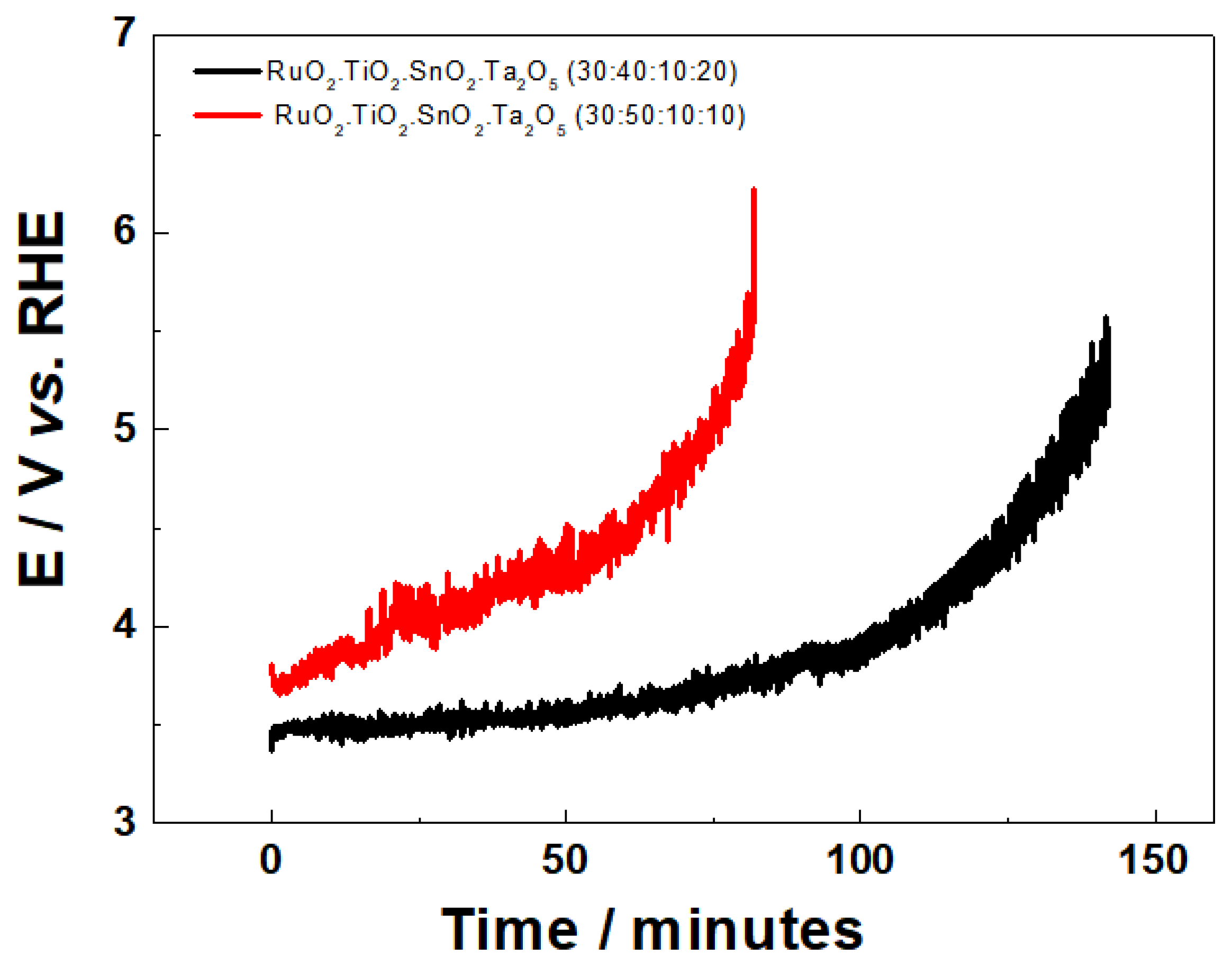
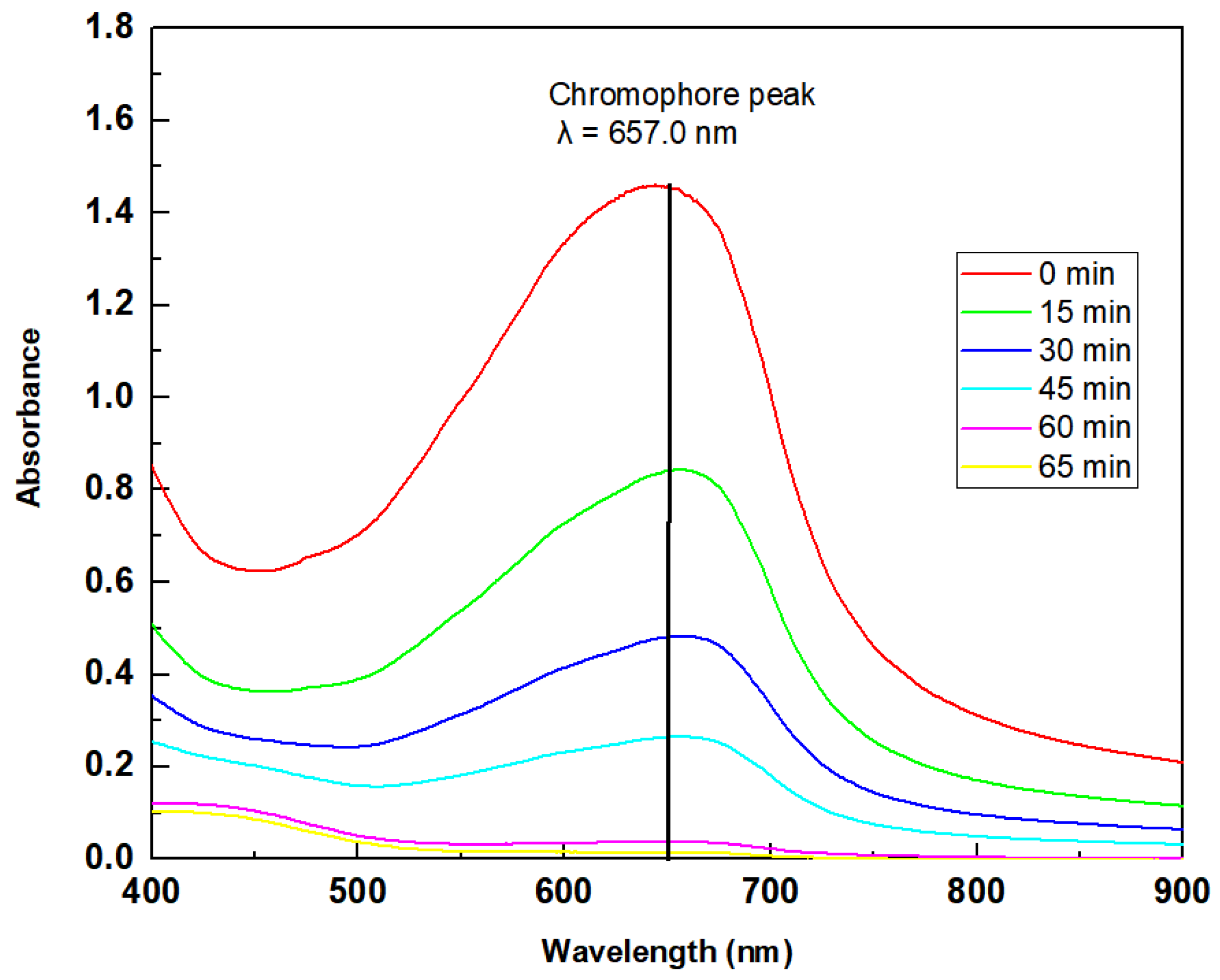
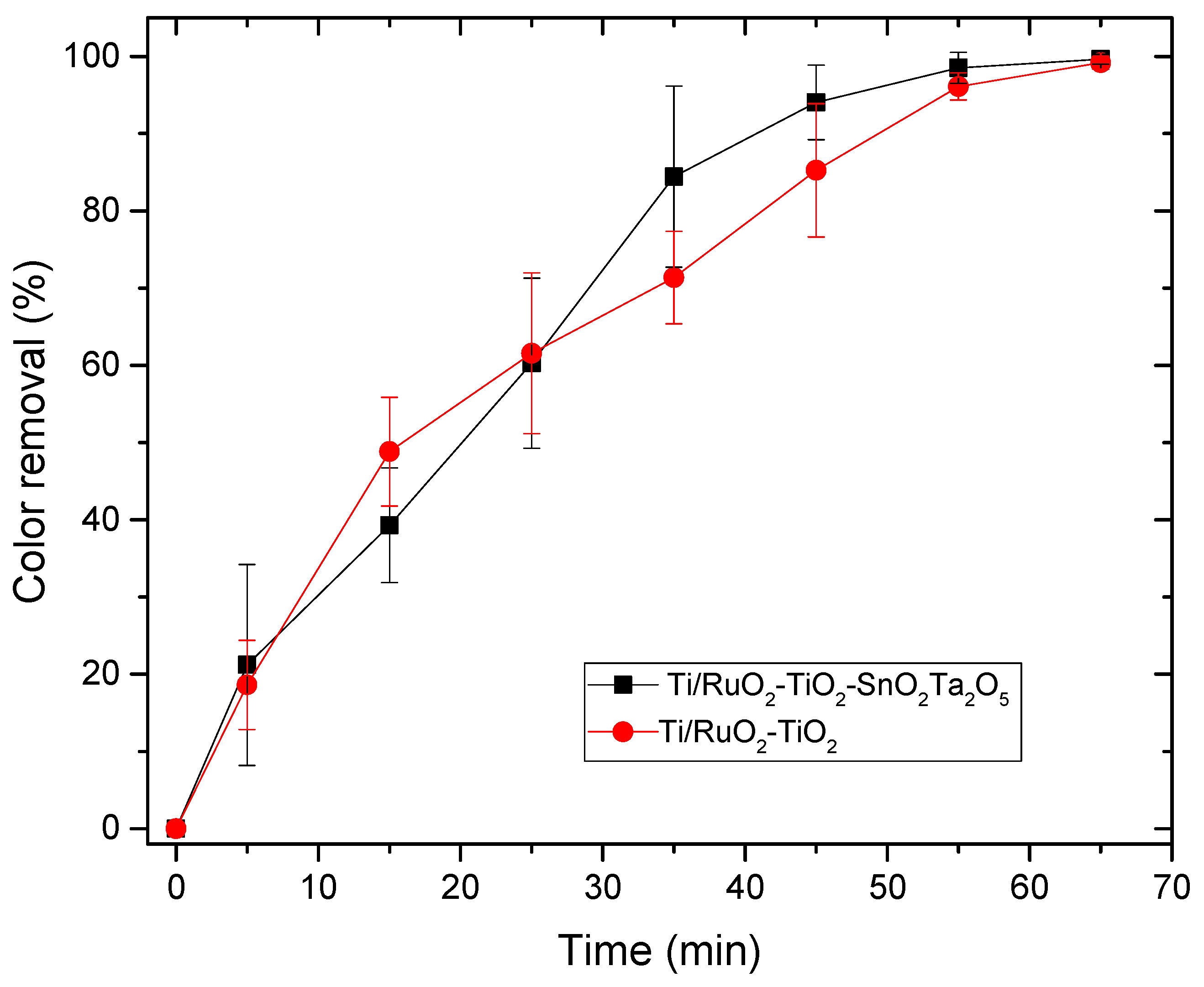
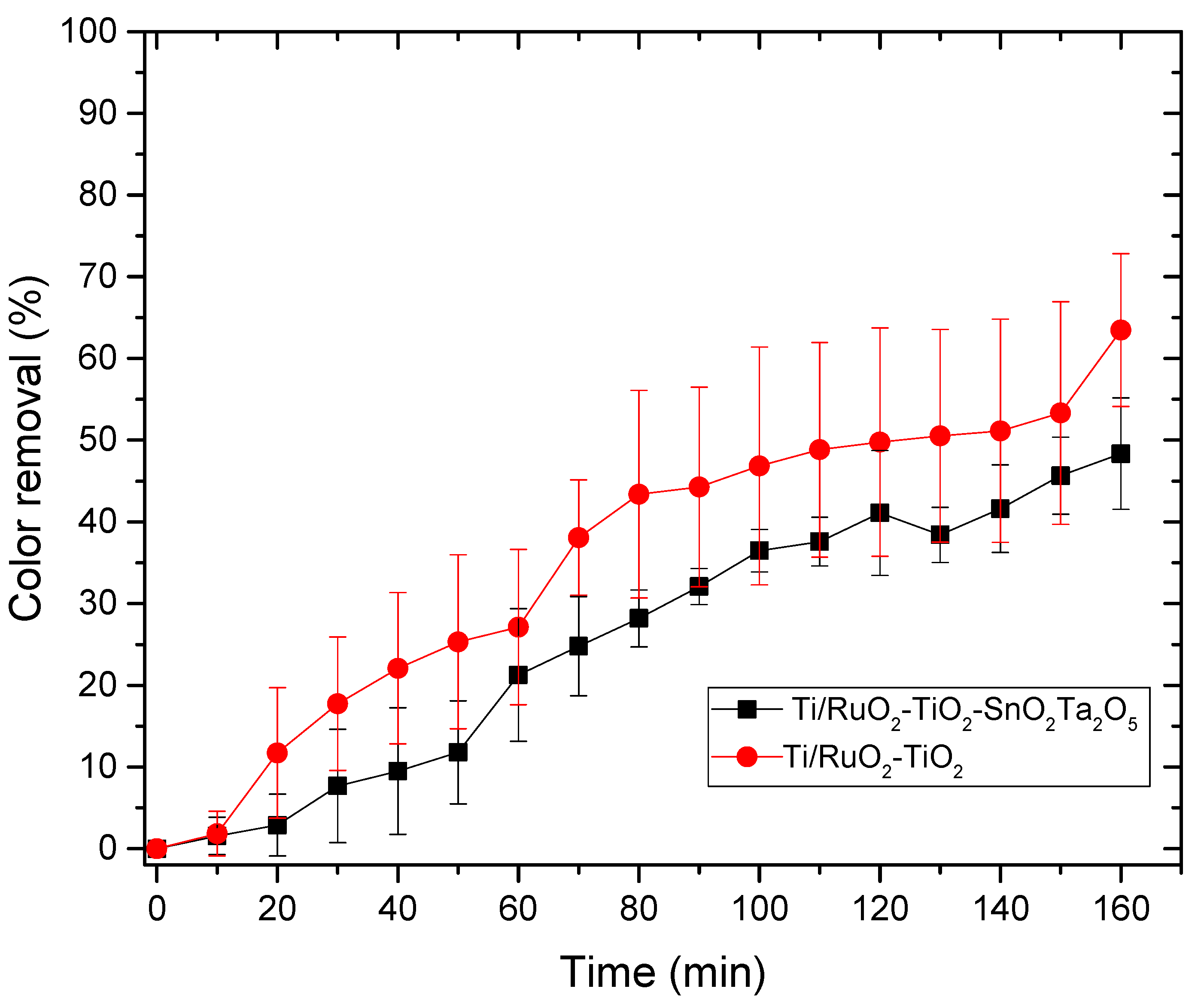
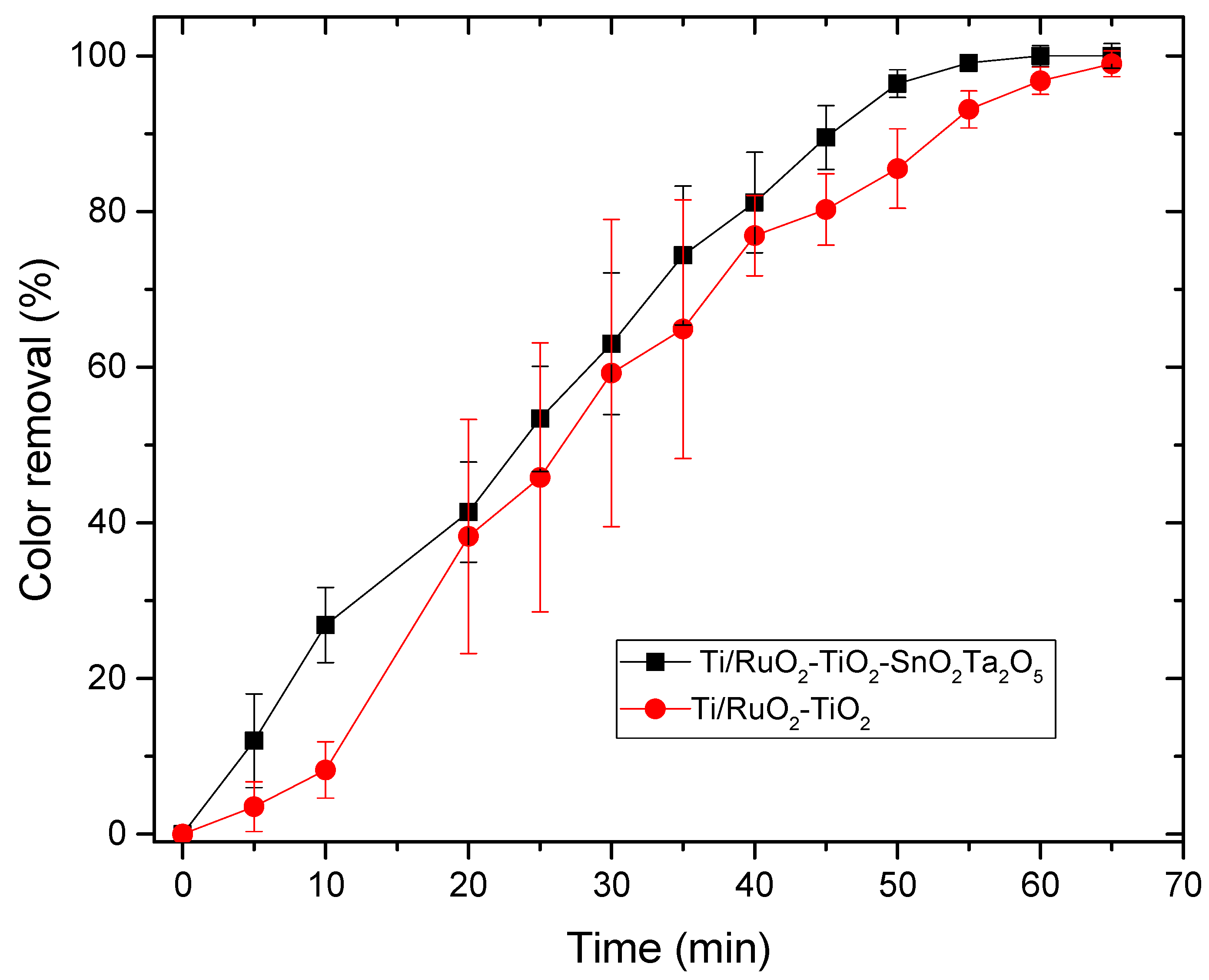

| Ion | Ionic Radius (nm) |
|---|---|
| Ru4+ | 0.062 |
| Ti4+ | 0.056 |
| Ta5+ | 0.068 |
| Sn4+ | 0.069 |
| Electrode Composition | Average Crystallite Size (nm) | ||||||||
|---|---|---|---|---|---|---|---|---|---|
| Nominal | Experimental (EDX) | 101 | 110 | 111 | 202 | 211 | 310 | 321 | 400 |
| Ti/RuO2-TiO2-SnO2-Ta2O5 (30:50:10:10) | Ti/RuO2-TiO2-SnO2-Ta2O5 (40:32:6:21) | - | - | 26 | 77 | 39 | - | 54 | - |
| Ti/RuO2-TiO2-SnO2-Ta2O5 (30:40:10:20) | Ti/RuO2-TiO2-SnO2-Ta2O5 (46:32:5:17) | - | 27 | 40 | 77 | 39 | - | 82 | - |
| Ti/RuO2-TiO2 (30:70) | Ti/RuO2-TiO2 (21:79) | 35 | 28 | - | - | 54 | - | - | 86 |
| Electrode | qa/C m−2 | qc/C cm−2 | qa/qc |
|---|---|---|---|
| H2SO4 0.050 mol L−1 | |||
| Sample 1—Ti/RuO2-TiO2-SnO2-Ta2O5 (30:40:10:20) | 19.0 | 22.6 | 0.843 |
| Sample 2—Ti/RuO2-TiO2-SnO2-Ta2O5 (30:40:10:20) | 10.0 | 11.3 | 0.881 |
| Sample 1—Ti/RuO2-TiO2-SnO2-Ta2O5 (30:50:10:10) | 16.5 | 18.9 | 0.873 |
| Sample 2—Ti/RuO2-TiO2-SnO2-Ta2O5 (30:50:10:10) | 21.8 | 25.1 | 0.868 |
| NaCl 0.167 mol L−1 | |||
| Sample 1—Ti/RuO2-TiO2-SnO2-Ta2O5 (30:40:10:20) | 15.4 | 21.6 | 0.712 |
| Sample 2—Ti/RuO2-TiO2-SnO2Ta2O5 (30:40:10:20) | 16.9 | 19.0 | 0.890 |
| Sample 1—Ti/RuO2-TiO2-SnO2-Ta2O5 (30:50:10:10) | 11.7 | 14.2 | 0.823 |
| Sample 2—Ti/RuO2-TiO2-SnO2-Ta2O5 (30:50:10:10) | 13.1 | 16.0 | 0.817 |
| Na2SO4 0.050 mol L−1 | |||
| Sample 1—Ti/RuO2-TiO2-SnO2Ta2O5 (30:40:10:20) | 12.2 | 14.5 | 0.835 |
| Sample 2—Ti/RuO2-TiO2-SnO2Ta2O5 (30:40:10:20) | 9.42 | 13.9 | 0.674 |
| Sample 1—Ti/RuO2-TiO2-SnO2Ta2O5 (30:50:10:10) | 10.8 | 10.8 | 0.994 |
| Sample 2—Ti/RuO2-TiO2-SnO2Ta2O5 (30:50:10:10) | 10.2 | 15.5 | 0.656 |
| Electrode | Time (min) |
|---|---|
| Ti/RuO2-TiO2-SnO2Ta2O5 (30:40:10:20) | 82 |
| Ti/RuO2-TiO2-SnO2Ta2O5 (30:50:10:10) | 142 |
| Technique | C0 (IB) | Conditions | Color Removal | Reference |
|---|---|---|---|---|
| Adsorption | 100 mg L−1 | 30 min, 3 g de vermicompost, 1000 rpm, 25 °C | 90% | 6 |
| Ligninolytic basidiomycete fungi | - | Fungi Phellinus gilvus 4 days, 25–30 °C | 100% | 26 |
| Photocatalysis + Fenton reagent | 25 mg L−1 | 45 min, UV light, Fenton reagents | - | 27 |
| Electrochemical discoloration | 26 mg L−1 | 60 min, 5 V, pH 4.5, 25 °C | 90% | 28 |
| Photocatalysis | 100 mg L−1 | 3 h, UV light, 25 °C | 63% | Present work |
| Electrocatalysis | 100 mg L−1 | 65 min, 20 mA, 25 °C | 100% | Present work |
| Photoelectrocatalysis | 100 mg L−1 | 60 min, luz UV, 20 mA, 25 °C | 100% | Present work |
Publisher’s Note: MDPI stays neutral with regard to jurisdictional claims in published maps and institutional affiliations. |
© 2022 by the authors. Licensee MDPI, Basel, Switzerland. This article is an open access article distributed under the terms and conditions of the Creative Commons Attribution (CC BY) license (https://creativecommons.org/licenses/by/4.0/).
Share and Cite
Tomaz, A.T.; Costa, C.R.; de Lourdes S. Vasconcellos, M.; Pedicini, R.; Ribeiro, J. Evaluation of Photoelectrocatalysis with Electrode Based on Ti/RuO2-TiO2 Modified with Tin and Tantalum Oxides for the Degradation of Indigo Blue Dye. Nanomaterials 2022, 12, 4301. https://doi.org/10.3390/nano12234301
Tomaz AT, Costa CR, de Lourdes S. Vasconcellos M, Pedicini R, Ribeiro J. Evaluation of Photoelectrocatalysis with Electrode Based on Ti/RuO2-TiO2 Modified with Tin and Tantalum Oxides for the Degradation of Indigo Blue Dye. Nanomaterials. 2022; 12(23):4301. https://doi.org/10.3390/nano12234301
Chicago/Turabian StyleTomaz, Alveriana Tagarro, Carla Regina Costa, Maria de Lourdes S. Vasconcellos, Rolando Pedicini, and Josimar Ribeiro. 2022. "Evaluation of Photoelectrocatalysis with Electrode Based on Ti/RuO2-TiO2 Modified with Tin and Tantalum Oxides for the Degradation of Indigo Blue Dye" Nanomaterials 12, no. 23: 4301. https://doi.org/10.3390/nano12234301
APA StyleTomaz, A. T., Costa, C. R., de Lourdes S. Vasconcellos, M., Pedicini, R., & Ribeiro, J. (2022). Evaluation of Photoelectrocatalysis with Electrode Based on Ti/RuO2-TiO2 Modified with Tin and Tantalum Oxides for the Degradation of Indigo Blue Dye. Nanomaterials, 12(23), 4301. https://doi.org/10.3390/nano12234301








